‘I am a nutrition professor, but I am also a cook,’ says Prof Xiao Jianbo. Dressed in a white apron, Prof Xiao skillfully wields the cooking utensils in the kitchen of Chao Kuang Piu College (CKPC) as he excitedly explains the medicinal properties of the ingredients on the counter. An assistant professor in the Institute of Chinese Medical Sciences (ICMS), and nutrition consultant to the CKPC, Xiao enjoys cooking and treats it as both an art and a science.’
Balancing the Five Tastes
Prof Xiao earned his PhD degree in nutrition from Okayama Prefectural University, Japan. Before joining UM in 2015, he was an Alexander von Humboldt Research Fellow at the University of Wurzburg in Germany, conducting research on nutrition, functional food based on Chinese medicines, dietary polyphenols, and medicinal plants. His studies have been widely cited by international peers. In 2016 and 2017, he was the only scholar of biomedical sciences from Macao to be included in the Highly Cited Researchers list released by Clarivate Analytics. The first principle Prof Xiao follows in cooking is ‘balancing the five tastes’ (sour, bitter, sweet, spicy, and salty), which he maintains is the key to healthy cooking. He explains, ‘A rule of thumb is to pair a meat ingredient with a vegetable one. If you stir-fry a plate of bok choy, of course it will be bland and boring. But if you throw in some shredded meat, it will instantly taste heavenly. Some people love cured meat, but it’s too salty to be eaten on its own, so you can put some bamboo shoots to balance out the salty flavour.’
Preferring Vegetables with Medicinal Properties
Xiao was born in Jiangsu, a Chinese province regarded as a land of milk and honey. He began dabbling in the culinary arts at the precocious age of seven. His favorite vegetables are some that are not familiar to most Macao residents but have medicinal properties such as purslane and India wormwood herb. ‘I usually don’t buy vegetables that are common and sold in abundance such as bok choy and cabbage. I prefer vegetables with medicinal properties such as celery. I won’t buy vegetables that are big and pretty. I prefer those that are small and short, because they usually don’t have pesticides.’ On the day of our interview, Prof Xiao made a specialmorning trip to the wet market to buy healthy ingredients. With the harvest from the market and the dried purslane from his hometown, he whipped up six dishes in less than two hours, to the amazement of everyone present. Purslane, one of his favorite ingredients in healthy cooking, is a succulent annual trailing plant that thrives in poor soil. A rich source of alkaloids, it is very healthy, and can even be used in the treatment of diabetes. Prof Xiao likes to stir-fry it on its own or throw in some steamed pork with pickled mustard greens to spice up the flavour. Prof Xiao told us that there is a line in the Confucian Analects that reads ‘Do not eat meat or liquor bought on the market.’ This is a piece of advice Prof Xiao follows wherever possible. ‘Normally, I don’t like to eat in restaurants, because you don’t know where they get their ingredients and whether they are fresh or not,’ he says. A voluntary cook for his wife and daughter almost every day, Prof Xiao is very health-conscious when it comes to the selection of ingredients. For instance, he uses brown or black sugar instead of white sugar. When making dumplings, he uses cooked meat rather than raw meat for a better taste. He also steams rather than cook shrimps to retain the natural sweet flavour.
Specialising in Dietary Polyphenols
When asked how an average person can maintain a balanced diet, Prof Xiao says that most people are able to get sufficient main nutrients (carbohydrates, fibres, fat, protein, and water) from their diet, the key is to get sufficient active ingredients, such as dietary polyphenols. As the associate editor of the Journal of Berry Research and someone who has been studying dietary polyphenols for many years, Prof Xiao highly recommends berries for their high content of dietary polyphenols, which confer antioxidant, anticancer, and antimicrobial protection. He explains, ‘Kiwi fruits, blueberries and strawberries all belong to the family of berries. They are nutritious but low in sugar. Two hundred grams of berries per day will provide sufficient daily intake of dietary polyphenols. Maybe of the one gram of dietary polyphenols you get, you will only absorb 5 to 10 per cent, but if you keep eating them every day, it will be good for your health. My family and I eat plenty of berries every day. My daughter especially likes blueberries and raspberries.’
Training the Next Generation of Cooks
In Prof Xiao’s opinion, an outstanding cook should have good knowledge of nutrition. When he was studying for his PhD degree in nutrition in Japan, he learned the importance of nutritional balance in cooking from the wife of his mentor. According to Prof Xiao, his mentor’s wife is just an ordinary housewife, but meticulously considers the nutritional aspect of cooking for every meal. ‘She never saves leftover food for the next day, and their family never eats overnight food, which is a pretty common practice in Japan,’ he said.
At UM, Prof Xiao teaches a general education course in nutrition and food safety. He also leads workshops on nutrition for students from CKPC to teach them how to select foods in the wet market and how to cook meals that are both healthy and tasty. ‘I think this is one way to teach students to practice healthy living. I hope to nurture a new generation of cooks armed with cultural knowledge and a good understanding of nutrition. This is the kind of cook that is lacking in today’s society.’
Source: My UM
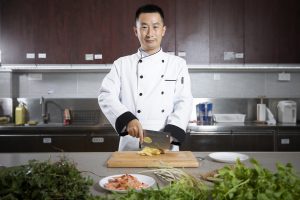
Prof Xiao Jianbo
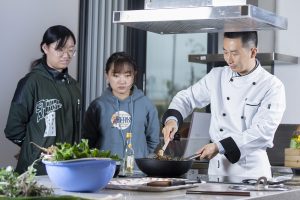
Prof Xiao often leads workshops to teach students to cook nutritious meals
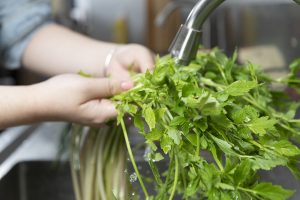
Celery is one of the medicinal vegetables Prof Xiao often uses in his cooking
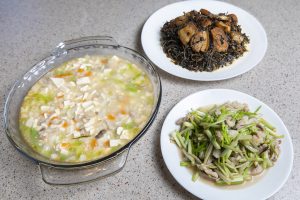
The dishes Prof Xiao cooked on the day of our interview were all made of natural ingredients, with minimum processing.
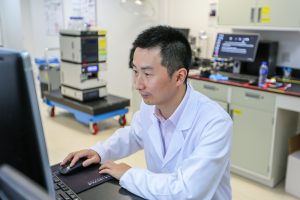
Prof Xiao is an outstanding researcher and cook
